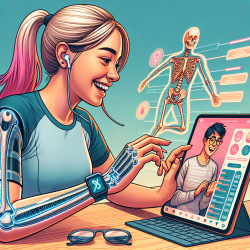Introduction
As a Special Education Director, staying informed about the latest research and technologies is crucial for providing the best support to students and staff. The study titled Evaluation of Digital Technologies Tailored to Support Young People’s Self-Management of Musculoskeletal Pain: Mixed Methods Study offers valuable insights into how digital tools can enhance self-management of musculoskeletal pain among young people. This blog will explore how practitioners can leverage these findings to improve their skills and encourage further research in digital therapy.
Understanding the Study
The study aimed to test the acceptability and need for adaptation of existing digital technologies, specifically the painHEALTH website and the iCanCope with Pain app, for young Australians with musculoskeletal pain. Conducted over three phases, the study involved user testing of website prototypes, a week-long engagement with the app, and interviews to gather participant experiences.
Key Findings
- User-Centered Design: The study emphasized the importance of youth-focused designs, vibrant color palettes, and engaging interfaces that motivate young users to interact with digital tools.
- Website Engagement: Participants preferred websites with easy navigation, clear layouts, and relatable content, including real-world patient stories that resonate with their experiences.
- App Functionality: The iCanCope with Pain app's daily check-ins encouraged self-reflection, while pain tracking supported positive behavioral changes and informed clinical consultations.
- Marketing and Promotion: Effective strategies for promoting these digital tools included health professional referrals, social media advertising, and testimonials from current users.
Implementing Research Outcomes
Practitioners can enhance their skills by integrating these findings into their practice. Here are some ways to do so:
- Adopt User-Centered Design: Ensure digital tools are designed with user engagement in mind, focusing on features that appeal to young people, such as vibrant colors and interactive elements.
- Enhance Digital Literacy: Encourage young people to use digital tools for self-management by providing guidance on navigating and utilizing these resources effectively.
- Collaborate with Developers: Work with technology developers to provide feedback and suggestions for improving digital tools, ensuring they meet the needs of young users with musculoskeletal pain.
- Promote Digital Tools: Use various channels, including social media and health professional networks, to raise awareness of available digital resources and their benefits.
Encouraging Further Research
While the study provides valuable insights, further research is needed to explore the long-term impact of digital tools on pain management and their integration into broader healthcare systems. Practitioners can contribute to this research by:
- Participating in Studies: Engage in research initiatives that evaluate the effectiveness of digital tools in different settings and populations.
- Sharing Experiences: Document and share experiences of using digital tools in practice to contribute to a growing body of evidence.
- Advocating for Funding: Support efforts to secure funding for research into digital health technologies, emphasizing their potential to improve patient outcomes.
To read the original research paper, please follow this link: Evaluation of Digital Technologies Tailored to Support Young People’s Self-Management of Musculoskeletal Pain: Mixed Methods Study.










